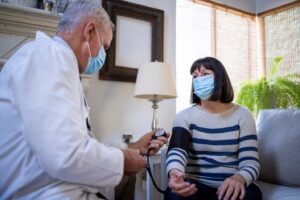How Smoking Affects Your Veins

Did you know that smoking is the leading preventable cause of death and illness in the United States? According to the National Institutes of Health (NIH), smoking is responsible for one in every five deaths. When people think of the risks of smoking, they tend to focus on the damage it does to the lungs and the elevated risk of lung cancer. Smoking does a lot more than that, though, damaging other parts of your body as well, including your blood cells, veins, and heart.
To reduce your risk of serious health conditions, you have to quit smoking. Cutting down on cigarettes won’t do the trick, because even light smoking and secondhand smoke send toxins into your veins. This can lead to life-threatening conditions like atherosclerosis, coronary heart disease, stroke, and abdominal aortic aneurysm. Peripheral artery disease (PAD) can also be the result of smoking-related blood disease. PAD is very serious and can cause a stroke, heart attack, and even the necessity for limb amputation. People who have additional risk factors like diabetes or obesity are at a greater risk of the vein and artery damage. However, even children can develop damaged blood vessels if exposed to second-hand smoke.
Why is smoking so bad for your veins? It’s because of all that cigarette smoke contains. There are chemicals like nicotine, which makes your heart work harder and require more oxygen, and carbon monoxide, which reduces the oxygen in your blood. Those two chemicals together are extremely damaging to your arterial walls and allow fatty deposits called plaques to build up. Plaques narrow the blood vessels and make it hard for blood to be pumped through them. Smoking also raises your bad cholesterol (LDL) while decreasing your good cholesterol (HDL) and this can lead to heart attacks and stroke.
If you’ve noticed varicose veins or spider veins in your face or legs, your veins are already damaged. Other symptoms that indicate vein damage include:
- Shortness of breath
- Dizziness
- Numbness of the hands, feet, legs, or arms
- Memory loss or confusion
- Irregular or rapid heartbeat
Fortunately, your veins begin to heal the moment you stop smoking. Though you may have residual damage and should definitely talk to your doctor about a vascular evaluation, your blood vessels will start repairing themselves once you quit. The benefits of quitting are dramatic:
- Within 20 minutes, your blood pressure and heart rate improve.
- One day after quitting, your risk of a heart attack will be lower.
- Within a month of quitting, you’ll have healthier cholesterol levels.
- After a year, your heart attack risk will be 50 percent lower.
- Several years after quitting, the cardiovascular system of a prior smoker will be as healthy as a lifelong nonsmoker.
If you’re seeking the very best care for your vein and blood flow issues, trust the board-certified physicians at the Arizona Vein & Laser Institute. Using the most advanced technology, the vascular and cardiovascular surgeons at the Arizona Vein & Laser Institute provide care for all types of venous diseases. With over 40 years of experience, our team of experienced physicians can devise the right treatment plan to address your venous disease problems. For more information contact us through our website.
